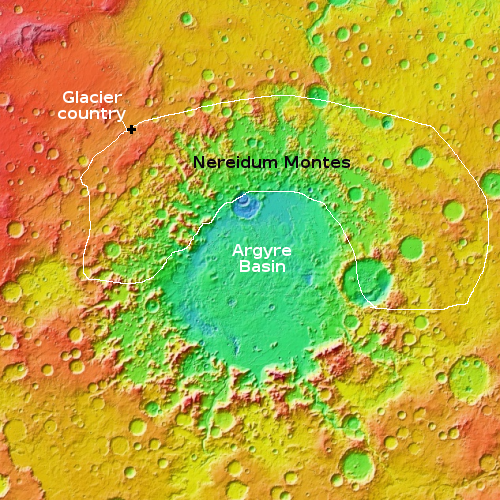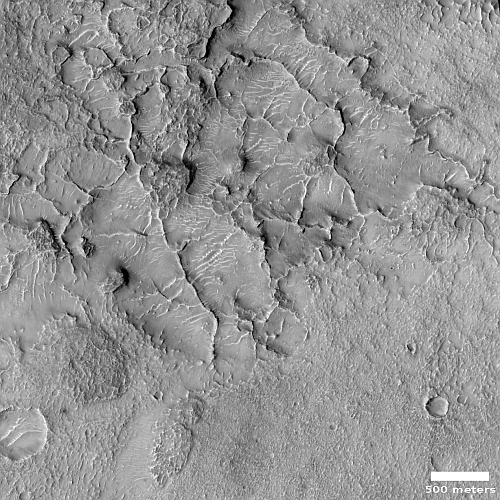Martian rectilinear ridges
Today’s cool image is also a bafflement. The photo to the right, cropped, reduced, and enhanced to post here, was taken on July 25, 2022 by the high resolution camera on Mars Reconnaissance Orbiter (MRO). The ridges in this picture are labeled by the scientists “Rectilinear Ridges,” but they really do not resemble any of the Martian rectilinear ridge types outlined in this paper [pdf], all of which appear to have a much more pronounced criss-cross pattern.
These ridges however are more meandering, and instead to my eye seem more like inverted channels, ancient channels whose beds became compacted and then became ridges when the less dense surrounding material eroded away. The problem with this conclusion however is the lack of any obvious tributary pattern. If these were once channels where either liquid water or glaciers once flowed, none of them seem to exhibit any drainage pattern. The ridges go in all directions.
The context map below only increases the mystery.

The black cross marks this picture’s location, about 600 miles from the center of 17,000-foot-deep Argyre Basin, the second deepest basin on Mars, after Hellas. Though it is on the edge of glacier country, and is also located at a latitude (39 degrees south) where many glaciers are found, little in this picture suggests glacial features. Instead, everything appears to be bedrock of one sort or another, with many sand dunes (the white streaks) scattered about.
The smooth area in the lower right might be impregnated with near surface ice, but if so it looks very different than almost any near surface ice I have yet seen on Mars. For example, the impact craters on it do not have that splattered look one expects from such near-surface-ice terrain.
Still, it is possible the difference between the relatively smooth plain to the south and the ridged area to the north exists because the surface ice has sublimated away in the north, revealing the underlying topography of ridges. That the smooth surface however more resembles bedrock and not icy topsoil makes this hypothesis unlikely.
Volcanism and hardened flood lava might explain these features, but even this doesn’t work entirely. For example, the ridges could be lava upwelling from cracks, except that their meandering nature says no.
All in all, a very typical Martian geological mystery.
On Christmas Eve 1968 three Americans became the first humans to visit another world. What they did to celebrate was unexpected and profound, and will be remembered throughout all human history. Genesis: the Story of Apollo 8, Robert Zimmerman's classic history of humanity's first journey to another world, tells that story, and it is now available as both an ebook and an audiobook, both with a foreword by Valerie Anders and a new introduction by Robert Zimmerman.
The print edition can be purchased at Amazon or from any other book seller. If you want an autographed copy the price is $60 for the hardback and $45 for the paperback, plus $8 shipping for each. Go here for purchasing details. The ebook is available everywhere for $5.99 (before discount) at amazon, or direct from my ebook publisher, ebookit. If you buy it from ebookit you don't support the big tech companies and the author gets a bigger cut much sooner.
The audiobook is also available at all these vendors, and is also free with a 30-day trial membership to Audible.
"Not simply about one mission, [Genesis] is also the history of America's quest for the moon... Zimmerman has done a masterful job of tying disparate events together into a solid account of one of America's greatest human triumphs."--San Antonio Express-News
Today’s cool image is also a bafflement. The photo to the right, cropped, reduced, and enhanced to post here, was taken on July 25, 2022 by the high resolution camera on Mars Reconnaissance Orbiter (MRO). The ridges in this picture are labeled by the scientists “Rectilinear Ridges,” but they really do not resemble any of the Martian rectilinear ridge types outlined in this paper [pdf], all of which appear to have a much more pronounced criss-cross pattern.
These ridges however are more meandering, and instead to my eye seem more like inverted channels, ancient channels whose beds became compacted and then became ridges when the less dense surrounding material eroded away. The problem with this conclusion however is the lack of any obvious tributary pattern. If these were once channels where either liquid water or glaciers once flowed, none of them seem to exhibit any drainage pattern. The ridges go in all directions.
The context map below only increases the mystery.

The black cross marks this picture’s location, about 600 miles from the center of 17,000-foot-deep Argyre Basin, the second deepest basin on Mars, after Hellas. Though it is on the edge of glacier country, and is also located at a latitude (39 degrees south) where many glaciers are found, little in this picture suggests glacial features. Instead, everything appears to be bedrock of one sort or another, with many sand dunes (the white streaks) scattered about.
The smooth area in the lower right might be impregnated with near surface ice, but if so it looks very different than almost any near surface ice I have yet seen on Mars. For example, the impact craters on it do not have that splattered look one expects from such near-surface-ice terrain.
Still, it is possible the difference between the relatively smooth plain to the south and the ridged area to the north exists because the surface ice has sublimated away in the north, revealing the underlying topography of ridges. That the smooth surface however more resembles bedrock and not icy topsoil makes this hypothesis unlikely.
Volcanism and hardened flood lava might explain these features, but even this doesn’t work entirely. For example, the ridges could be lava upwelling from cracks, except that their meandering nature says no.
All in all, a very typical Martian geological mystery.
On Christmas Eve 1968 three Americans became the first humans to visit another world. What they did to celebrate was unexpected and profound, and will be remembered throughout all human history. Genesis: the Story of Apollo 8, Robert Zimmerman's classic history of humanity's first journey to another world, tells that story, and it is now available as both an ebook and an audiobook, both with a foreword by Valerie Anders and a new introduction by Robert Zimmerman.
The print edition can be purchased at Amazon or from any other book seller. If you want an autographed copy the price is $60 for the hardback and $45 for the paperback, plus $8 shipping for each. Go here for purchasing details. The ebook is available everywhere for $5.99 (before discount) at amazon, or direct from my ebook publisher, ebookit. If you buy it from ebookit you don't support the big tech companies and the author gets a bigger cut much sooner.
The audiobook is also available at all these vendors, and is also free with a 30-day trial membership to Audible.
"Not simply about one mission, [Genesis] is also the history of America's quest for the moon... Zimmerman has done a masterful job of tying disparate events together into a solid account of one of America's greatest human triumphs."--San Antonio Express-News


